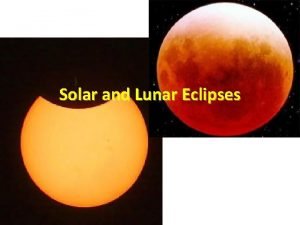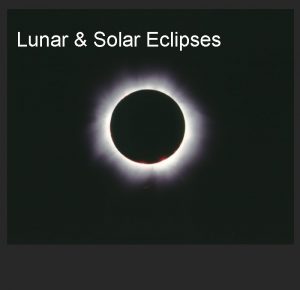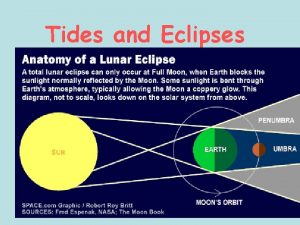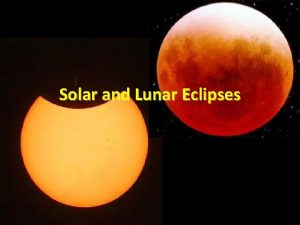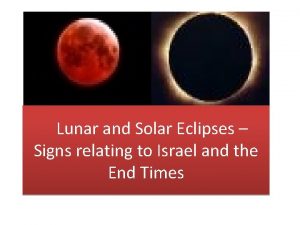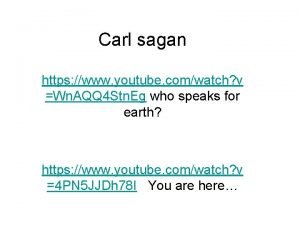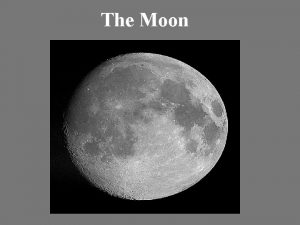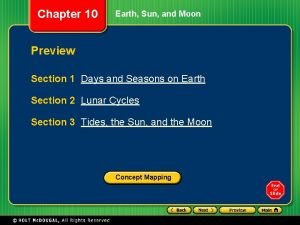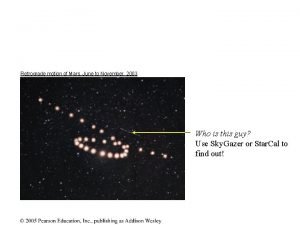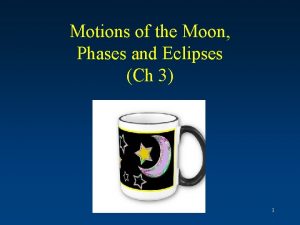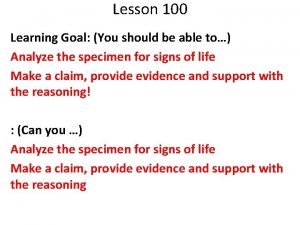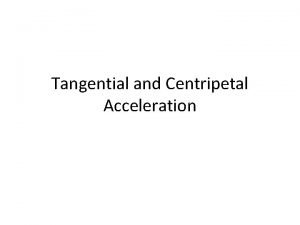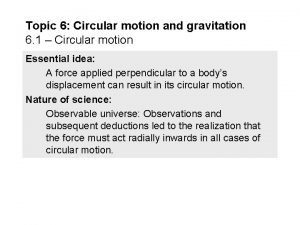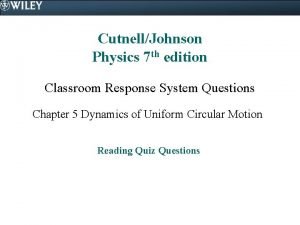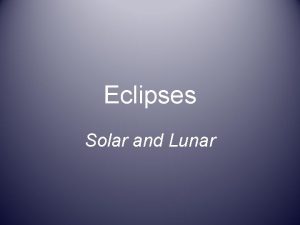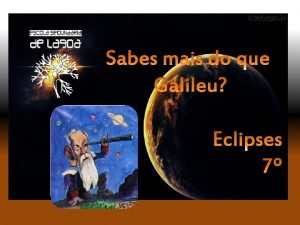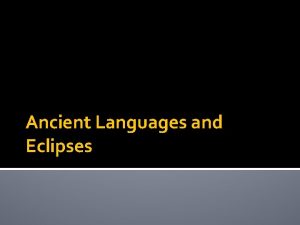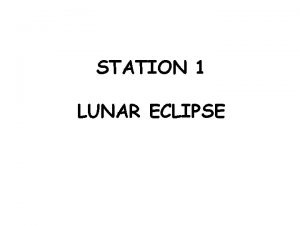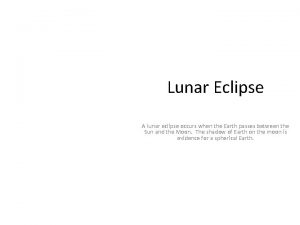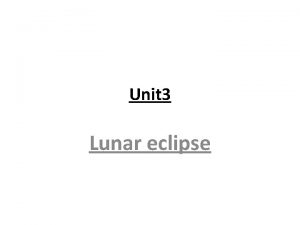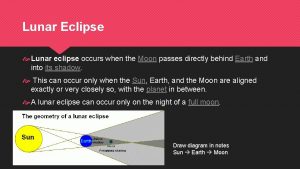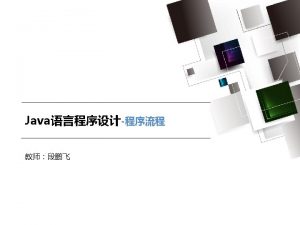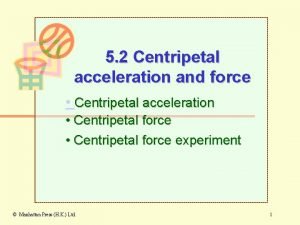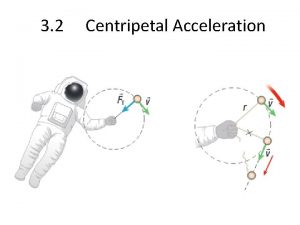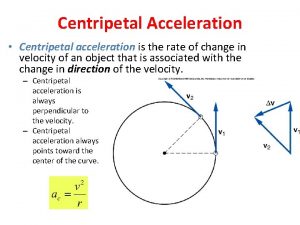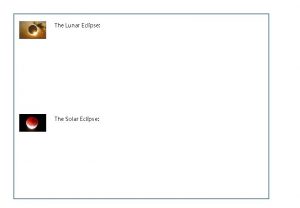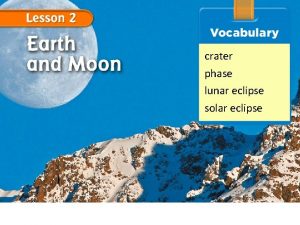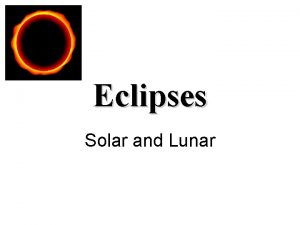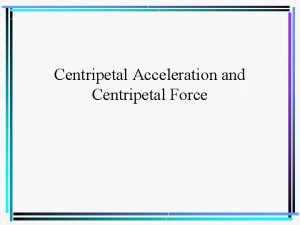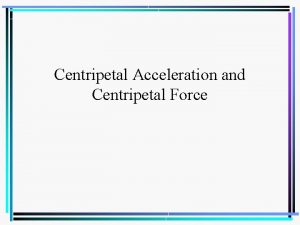Solar and Lunar eclipse Centripetal Acceleration Centripetal acceleration























- Slides: 23

Solar and Lunar eclipse

Centripetal Acceleration • Centripetal acceleration is the rate of change in velocity of an object that is associated with the change in direction of the velocity. – Centripetal acceleration is always perpendicular to the velocity. – Centripetal acceleration always points toward the center of the curve.

Centripetal Forces • The centripetal force may be due to one or more individual forces, such as a normal force and/or a force due to friction. .

• The friction between the tires and road produces the centripetal acceleration on a level curve.

On a banked circular track, assuming no friction on the surface, will the ball be able to make a circular motion with constant speed? A). Yes. B). No. friction is absolutely needed.

v The normal force can be separated into a vertical component and a ho v The horizontal component of the normal force is the centripetal force when there’s no friction in order to keep the object (car) on the circular track.

Quiz: A Car moves along a banked circular track (θ=30 o) and experience a normal force of 1000 kg. How large is the vertical component (Fv) and horizontal component (Fh)? A). Fv = 866 kg, Fh = 500 kg. B). Fv = 500 kg, Fh = 866 kg. C). Fv = 500 kg, Fh = 500 kg D). Fv = 866 kg, Fh = 134 kg. Fh = N cos(30 o) Fv = N sin(30 o)

1 D-02 Conical Pendulum Could you find the NET force? T sin(θ) = mv 2/R T cos(θ) = mg v = sqrt( g. R tan(θ) ) Period of the pendulum τ= 2πR/v, where R = L / sin(θ) τ= 2π sqrt( Lcos(θ)/g ) • NET FORCE IS TOWARD THE CENTER OF THE CIRCULAR PATH • Why R become smaller as time goes by? • T sin(θ) has to be smaller while T=mg/cos(θ) increase 9/30/2020 Physics 214 Fall 2010 with larger θ 8

Springs Tension

1 D-09 Centripetal Force Will the two carts move away from each others ? A). yes. B). No. they will move closer to each other C). No. their distance will not change. .

Vertical circles N v W = mg mg – N = mv 2/r • If v = 0 then N = mg g + is always toward the center of the circle • As v increases N becomes smaller • When v 2/r = g the car becomes weightless. 9/30/2020 Ferris wheel At the bottom N - mg = mv 2/r At the top Mg – N = mv 2/r Physics 214 Fall 2010 11

A floating dog http: //www. digitaljournal. com/image/71076 https: //www. youtube. com/watch? v=6 Nv. BGb 5 lf 78 12

1 D-05 Twirling Wine Glass m v Is it possible. to keep the water in the cut upside down? Same as g string N + mg = mv 2/R N > 0 9/30/2020 Physics 214 Fall 2010 13

1 D-07 Paper Saw • THE RADIAL FORCES HOLDING THE PAPER TOGETHER MAKE THE PAPER RIGID. Is paper more rigid than wood ? 9/30/2020 Physics 214 Fall 2010 14

Ch 5 CP 2 A Ferris wheel with radius 12 m makes one complete rotation every 8 seconds. What speed do riders move at? A). 56. 52 m/s B). 9. 42 m/s C). 18. 84 m/s D). 4. 71 m/s Fcent 2 m r=1 S = d/t = 2 r/t = 2 (12 m)/8 s = 9. 42 m/s 9/30/2020 Physics 214 Fall 2010 15

Ch 5 CP 2 A Ferris wheel with radius 12 m makes one complete rotation every 8 seconds. What is the magnitude of their centripetal acceleration? A). 7. 40 m/s 2 B). 9. 40 m/s 2 C). 3. 70 m/s 2 D). 14. 80 m/s 2 Fcent acent = v 2/r = s 2/r = (9. 42 m/s)2/12 m = 7. 40 m/s 2 9/30/2020 Physics 214 Fall 2010 2 m r=1 16

Ch 5 CP 2 A Ferris wheel with radius 12 m makes one complete rotation every 8 seconds. For a 40 kg rider, what is magnitude of centripetal force to keep him moving in a circle? Is his weight large enough to provide this centripetal force at the top of the cycle? A). 396 N, weight is large enough. B). 1028 N, weight is large enough C). 200 N, weight is large enough D). 296 N, weight is large enough E). 296 N, weight is NOT large enough Fcent 2 m r=1 Fcent = m v 2/r = m acent = (40 kg)(7. 40 m/s 2) = 296 N W = mg = (40 kg)(9. 8 m/s 2) = 392 N Yes, his weight is larger than the centripetal force required. 9/30/2020 Physics 214 Fall 2010 17

Ch 5 CP 2 A Ferris wheel with radius 12 m makes one complete rotation every 8 seconds. What is the magnitude of the normal force exerted by the seat on the rider at the top? A). 100 N B). 96 N C). 90 N D). 50 N E). 48 N Fcent W – Nf = 296 9/30/2020 2 m r=1 N = 96 newtons Physics 214 Fall 2010 18

Ch 5 CP 2 A Ferris wheel with radius 12 m makes one complete rotation every 8 seconds. What would happen if the Ferris wheel is going so fast the weight of the rider is not sufficient to provide the centripetal force at the top? Note: there’s no safe belt. A) rider is ejected B) Rider remain on seat 9/30/2020 Fcent 2 m r=1 19

Ch 5 CP 4 A passenger in a rollover accident turns through a radius of 3. 0 m in the seat of the vehicle making a complete turn in 1 sec. what is speed of passenger? A). 38 m/s B). 22 m/s C). 19 m/s D). 11 m/s E). 125. 3 m/s 3 m s = d/t = 2 (3. 0 m)/1 = 19 m/s 9/30/2020 Physics 214 Fall 2010 20

Quiz A passenger in a rollover accident turns through a radius of 3. 0 m in the seat of the vehicle making a complete turn in 1 sec. What is centripetal acceleration? Compare it to gravity (g = 9. 8 m/s 2) A). 118 m/s 2 B). 128 m/s 2 C). 138 m/s 2 D). 108 m/s 2 E). 98 m/s 2 a= v 2/r = 9/30/2020 s 2/r = (19 m/s)2/3 m = 118 m/s 2 = 12 xg Physics 214 Fall 2010 3 m 21

Ch 5 CP 4 A passenger in a rollover accident turns through a radius of 3. 0 m in the seat of the vehicle making a complete turn in 1 sec. Passenger has mass = 60 kg, what is centripetal force required to produce the acceleration? Compare it to passengers weight. A). 10000 N B). 1352 N C). 7080 N D). 1159. 3 N E). 205 N m/s 2) F = ma = (60 kg)(118 = 7080 N F = ma = m (12 X 9. 8 m/s 2) = 12 mg = 12 weight 9/30/2020 Physics 214 Fall 2010 3 m 22

How Tough is 12 g? What’s shown in the video is < 10 g.
 Differentiate between lunar eclipse and solar eclipse
Differentiate between lunar eclipse and solar eclipse Solar lunar eclipse
Solar lunar eclipse Difference between lunar and solar eclipse
Difference between lunar and solar eclipse Tides and eclipses
Tides and eclipses What is an eclipse
What is an eclipse Criciúma ec
Criciúma ec Ano ang pagkakaiba ng solar at lunar eclipse
Ano ang pagkakaiba ng solar at lunar eclipse Circular acceleration
Circular acceleration Tangential acceleration and centripetal acceleration
Tangential acceleration and centripetal acceleration Is radial acceleration the same as centripetal acceleration
Is radial acceleration the same as centripetal acceleration Lunar eclipse israel
Lunar eclipse israel Carl sagan lunar eclipse
Carl sagan lunar eclipse Whats a natural satellite
Whats a natural satellite Solar eclipse chapter 10
Solar eclipse chapter 10 Partial lunar eclipse
Partial lunar eclipse Lunar eclipse moon phase
Lunar eclipse moon phase Dua for lunar eclipse in islam
Dua for lunar eclipse in islam Raphael eclipse
Raphael eclipse 300 solar years to lunar years
300 solar years to lunar years Tangential speed definition
Tangential speed definition 6-1 centripetal acceleration and force
6-1 centripetal acceleration and force 6-1 centripetal acceleration and force
6-1 centripetal acceleration and force Centripetal acceleration unit
Centripetal acceleration unit Centripetal acceleration physics classroom
Centripetal acceleration physics classroom
